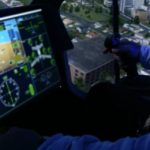Airspeeder’s new eVTOL sport could help win the battle for public acceptance for urban air mobility technologies.
Chief Commercial Officer Jack Withinshaw explained that the company, which was established in 2016, was “building a brand new sport from scratch” as well as a whole new technology in eVTOLs. He explained: “The Mark III is a 4.1 metre long electric octocopter that we announced in 2020 and through the pandemic we’ve been testing that vehicle to its limits and we’re now excited to say in 2022 we are having our first three races this year.”
Withinshaw explained that Airspeeder could play a leading role in promoting public acceptance of UAM technology at a time when OEMs including Joby, Volocopter, Lilium were already building vehicles. He added: “We’re really excited to be able to show that to the public and to show them what these vehicles can do as well. For us, it’s about getting the vehicles out there, giving them racing in a nice, snackable size format that is sport and spread the message of eVTOL and UAM far and wide.”
Pilots – the “human faces” behind eVTOL technology

Withinshaw said sustainability was a vital aspect for the vehicles but public demand for sustainable transport was even more important. He explained that the human experience that the sport offers could help make that a reality: “We all want the sustainable future but there is a key part there which is that we want people to want that as well. We want the public to fall in love with what this technology can do and racing does offer that, but also offers another touch point, not only can we have human faces with pilots that you can rally behind and start to cheer on but we want you to experience it as well so that you can democratise the experience of flying cars. For us, that means not only seeing it on screen, seeing your heroes flying at the edge of their capabilities, but also bring it down to a simulator level and eSports level. There is so much in the world of Airspeeder that we can bring to life that can encourage flying cars to the forefront.”
He added that the “flying car” had been part of popular culture for many years, adding: “We’re here to say to the public that it’s available now and to show them what we can do.”
Manufacturer will look to offset parts of the technology tree
Airspeeder’s vehicles are currently manufactured in-house, by the company’s manufacturing arm Alauda. “We weren’t willing to wait for the market to come and build one for us we had to go and build it ourselves and it’s not always going to be like that though. We are looking to offset certain parts of the technology tree to our teams to take over that innovation journey and in doing that those OEMs can come in, they can develop their expertise in motors, batteries, powertrains, aero packages and eventually take full control over it to the level we get to Formula One. In doing that we are now spreading the technology and the investment in these this this types of vehicles far and wide globally to help kind of accelerate the urban air mobility dream that we’ve all we’ve all been wanting.”
Withinshaw explained that the Airspeeder series would see multiple vehicles all in the air at the exact same time. Initially, the races will fly the mach 3 series, an uncrewed, electric octocopter which pilots will be racing from the ground.
Uncrewed eVTOLs offer opportunity for “extreme racing”
“That’s fantastic for us because it means we can do extreme racing this year but we can also take a bunch of learnings before we start moving into the crewed vehicles later on,” explained Winthinshaw. “Each year we’re going to be not only expanding the roster of teams that we have in the series but we will also be expanding a number of locations, so this is a global series I can’t say the locations just yet, but we will be introducing it to all different parts of the globe.”
In the future, he said Airspeeder has ambitious to create a global sport based on crewed vehicles. “We’d love to be able to get up to that F1 grid where we have 20 vehicles each team has two vehicles all in the air at the exact same time. Safety is a key point there where there’s a crewed craft so having a rigorous well-tested anti-collision software in place to be able to stop the vehicles from physically touching but digitally bumping would be really important. Getting there means that we can bring this not only to life with multiple vehicles in the air but also into this public sphere as well, eventually, when we’re ready.”
Pandemic left team with time to “crack on and develop vehicles”
Withinshaw said Airspeeder had got through the pandemic with the help of “sheer grit and determination.” He added that the eVTOLs are manufactured in Australia which was initially largely unaffected by the pandemic, having shut its borders throughout 2020 meaning that the team had a lot of time to “crack on and develop the vehicles and test them out.”
Withinshaw said this had become more challenging when lockdown restrictions were introduced in Australia resulting in pilots becoming stuck interstate which made testing more difficult as well as supply chain issues that the rest of the aerospace industry had suffered from. But with the introduction of Covid vaccines and infection rates decreasing, Withinshaw concluded: “I can’t think of a better time to introduce a new generation of motorsport.”

